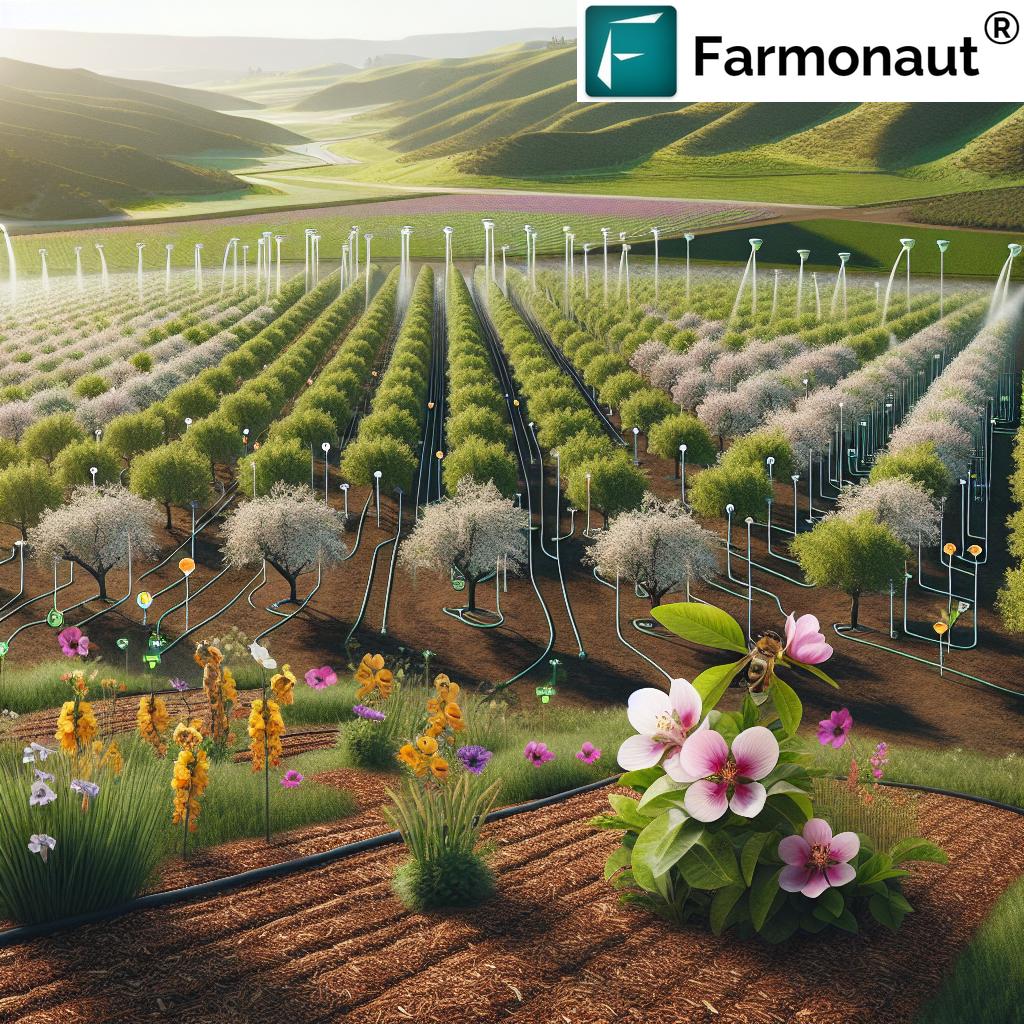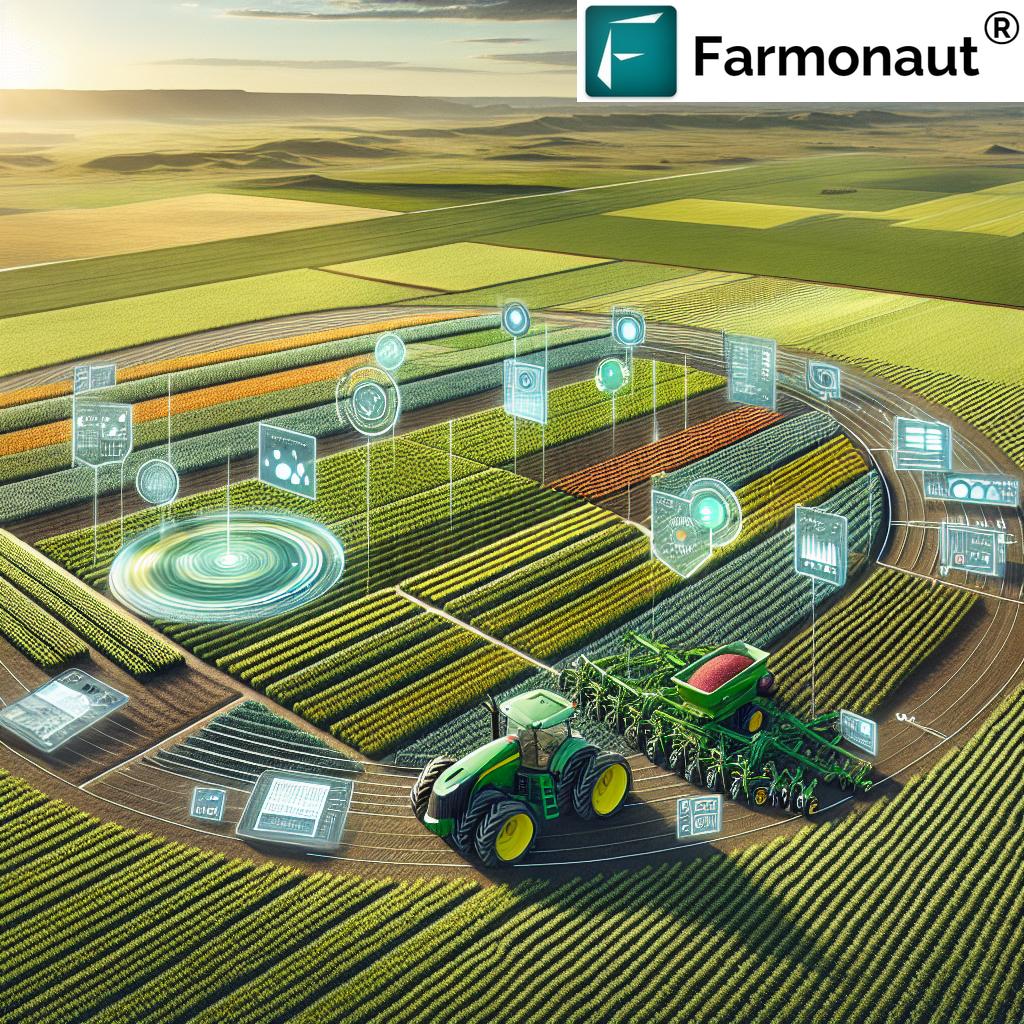AI Spot Wildfires: CA Wildfire Containment Challenges 2024
Table of Contents
- Introduction: Unprecedented Challenges of California Wildfire Season 2024
- California Wildfire Season 2024 Damage Statistics
- California Wildfire Containment Challenges: What We Face in 2025
- How AI Spot Wildfires: Technologies Redefining Wildfire Management
- Innovative AI Detection Strategies and Predictive Modelling
- AI in Agriculture & Forestry: Minimizing Risk and Maximizing Resilience
- 2024 California Wildfire Damage & AI Intervention Comparison Table
- Farmonaut: Empowering Wildfire Risk Management with Satellite & AI
- The Future: Overcoming Wildfire Containment Challenges in California
- FAQ: California Wildfire Containment & AI Wildfire Spotting
“In 2024, AI systems detected California wildfires up to 4 hours faster than traditional methods, improving early response times.”
Introduction: Unprecedented Challenges of California Wildfire Season 2024
The California wildfire season 2024 has shattered previous records, drawing global attention to the rising risks and enormous challenges facing the state. As wildfires swept across millions of acres, causing unprecedented damage to homes, businesses, agricultural lands, and forests, the urgent need for innovative detection, management, and containment approaches was reinforced like never before. This catastrophic season has not only left a lasting mark on California’s environment, economy, and communities, but has also redefined what it means to manage and contain wildfires in the modern age.
The transition from 2024 to 2025 signals a critical turning point for wildfire management across California. The state, particularly Napa, Sonoma, and other vital agricultural and forestry regions, is facing a future where climate extremes and complex land use patterns intensify the wildfire threat every year. In this context, AI spot wildfires capabilities represent one of the most promising advancements in combating these fires—enabling faster, smarter, and more coordinated responses to California wildfire containment challenges.
In this comprehensive analysis, we explore how artificial intelligence (AI) is transforming wildfire management, providing detailed California wildfire season 2024 damage statistics, examining containment challenges, and highlighting the technological breakthroughs that are redefining the fight against uncontrolled fires in the state.
California Wildfire Season 2024 Damage Statistics: The Data Behind the Crisis
“California recorded over 1.3 million acres burned in 2024, as AI-driven detection networks monitored high-risk zones continuously.”
The 2024 wildfire season stands as a grim testament to the intensifying danger posed by climate change, land management challenges, and population growth in California. Let’s break down the key statistics that define this extraordinary year:
- Over 2.5 million acres burned: Surpassing previous records, wildfires scorched vast tracts of forests, grasslands, agricultural fields, and residential districts.
- Thousands of homes destroyed: Residential communities at the urban-wildland interface bore the brunt of the destruction, heightening the social and economic impact across the state.
- Significant agricultural losses: Key regions like Napa and Sonoma saw viticulture assets—especially vineyards supporting California’s globally renowned wine industry—suffer extensive smoke and heat damage. The result: reduced yields, compromised quality, and long-term economic setbacks.
- Forest devastation: Commercial timber production and ecological biodiversity were severely disrupted. Post-fire, many areas faced heightened risks of erosion, water contamination, pests, and diseases that compound the challenge of environmental recovery.
- Infrastructure at risk: Power grids, highways, and critical irrigation networks experienced direct fire threats or were cut off due to rapid spread, impacting the continuity of essential services.
The scope of this devastation clearly illustrates why the California wildfire containment challenges in 2025 and beyond are so daunting, and why AI spot wildfires is increasingly at the core of innovative management strategies.
Facing California Wildfire Containment Challenges in 2025
Containing wildfires has always been a complex endeavor, but the 2024 season revealed new layers of difficulty. Let’s examine the core challenges:
1. Rapid and Unpredictable Fire Spread
- Changing weather patterns: Increasingly frequent and intense droughts, coupled with erratic wind events, produce volatile wildfires that jump across firebreaks and geographical barriers.
- Unpredictable behavior: Fires in 2024 demonstrated rapid shifts in direction and intensity, outpacing both ground crews and aerial surveillance capabilities.
2. Limitations of Traditional Approaches
- Speed and coverage limitations: Ground crews, manned aircraft, and lookout towers can only oversee limited areas and often detect fires after significant spread has already occurred.
- Rugged terrain: Many wildfire-prone areas in California feature mountains, forests, and canyons that physically restrict access and reduce the effectiveness of traditional monitoring.
- Safety risks: Firefighters are continuously exposed to extreme conditions and fast-moving fires, resulting in increased threat to life during containment and rescue efforts.
3. Resource Allocation & Agency Coordination
- Multiple agencies: Effective wildfire management requires rapid information sharing and action among state, federal, and local agencies, but coordination can be hampered by overlapping responsibilities and budget constraints.
- Resource limitations: Firefighting resources, including personnel, vehicles, aircraft, and firefighting agents (like water or retardant), are frequently stretched thin during simultaneous major outbreaks.
4. Expanding Urban-Wildland Interface
- Increasing exposure: As communities and farmlands expand into historically wild regions, the number of people and properties at risk from wildfire outbreaks continues to rise each year.
How AI Spot Wildfires: Transforming Detection & Management in California
The deployment of AI spot wildfires systems has begun to fundamentally change how wildfire outbreaks are detected, tracked, and contained across California. AI-driven solutions leverage data from satellites, drones, weather models, and ground sensors to provide continuous, real-time, and actionable insights, enabling a dynamic response to evolving fire threats.
Key Applications of AI in Wildfire Detection and Containment
- Early fire detection: AI analyzes thermal anomalies and visual patterns from satellite and drone imagery, detecting fires that humans might miss or spot only after they grow larger. Many AI systems now use pattern recognition and smoke detection to alert authorities—often within minutes of fire ignition.
- Predictive fire behavior modelling: Advanced AI models synthesize data on wind, temperature, humidity, fuel loads, and topography, forecasting likely fire spread and behavior hours or days ahead.
- Resource optimization: AI-powered platforms rapidly compare multiple scenarios, helping firefighting agencies determine the best deployment of crews, equipment, and aerial support to maximize containment value and minimize risk to life and property.
- Critical infrastructure protection: Machine learning models help prioritize protection for vital assets like power grids, irrigation systems, and transportation corridors, alerting operators before fire fronts approach sensitive zones.
- Continuous environmental monitoring: By automating the assessment of vegetation health, soil moisture, and water availability, AI provides ongoing risk assessments that support both short-term emergency response and long-term land management strategies.
In 2024, these applications were not only pilot-tested but also deployed at scale in select regions, contributing to improved response times and better management outcomes amidst some of the most devastating outbreaks ever seen in the state.
Innovative AI Detection Strategies and Predictive Modelling
Let’s dive deeper into the specific AI techniques and technology stacks now revolutionizing California wildfire containment challenges:
Multispectral and Thermal Imaging
- Data fusion: AI combines visible, infrared, and thermal bands from satellite feeds to identify heat signatures, smoke columns, and potential ignition points with far greater accuracy and speed than manual monitoring.
- Geospatial analytics: Integration with mapping tools allows rapid geo-referencing, alerting both first responders and the public to developing threats in their vicinity.
Real-time Sensor Networks and IoT Devices
- Ground-based sensors: IoT devices scattered through risk zones measure temperature, humidity, soil moisture, and wind direction—providing real-time feeds for fine-tuned risk assessment.
- Edge AI: On-device analysis helps filter noise and send actionable alerts immediately to centralized command centers or automated dispatch systems.
Machine Learning for Smoke & Pattern Detection
- Smoke recognition: AI models trained to recognize subtle differences in smoke plumes, color, and movement can spot fires hours ahead of satellite-confirmed ignition, particularly in remote or heavily wooded locations.
- Outbreak prediction: By analyzing weather models, fuel conditions, and topography, machine learning algorithms determine the potential for a hotspot to escalate into a major wildfire.
Advanced Predictive Modelling
- Wind and weather forecasting: AI interprets microclimate models, simulating fire spread scenarios based on changing humidity, wind shifts, and temperature spikes common across California’s diverse geography.
- Resource dispatch simulation: AI engines run thousands of containment strategies within minutes, helping agencies choose the most effective allocations for reducing overall fire damage and risk to populations.
For those seeking to build or integrate advanced wildfire detection and monitoring systems, Farmonaut’s Satellite & Weather AI API offers robust, scalable, real-time data feeds. Access extensive developer docs here.
AI in Agriculture & Forestry: Minimizing Risks, Maximizing Resilience
Agricultural and forestry sectors are on the frontline of california wildfire containment challenges. Recognizing the vital importance of these industries to California’s economy and food security, farmers and forest managers are increasingly adopting AI-driven strategies to both reduce wildfire risks and speed up recovery after fire events.
AI-Powered Crop & Land Monitoring
- Vegetation indexes (NDVI, NDWI): Farmonaut’s multispectral monitoring capabilities allow users to analyze crop vigor, soil moisture, and drought stress—all critical factors in wildfire vulnerability.
- Water management optimization: AI analyzes irrigation patterns, pinpointing over- or under-watered areas to reduce hyper-flammable zones within crop and orchard systems.
Proactive Firebreak Planning and Fuels Management
- Firebreak strategy: AI helps map where to establish firebreaks or buffer zones most efficiently, considering prevailing wind direction, topography, and seasonal vegetation loads.
- Controlled burns: Data-driven prioritization helps forest managers select parcels for prescribed burns, reducing fuel accumulation that can intensify wildfires.
Real-Time Alerts & Fleet Management
- Asset tracking: Know exactly where machinery, vehicles, and valuable resources are at any given time in case evacuation or redeployment is necessary.
- Smart notifications: With tailored AI-based advisories, swift action can be recommended to land managers in high-risk times or locations.
Large-scale farm and forest operators can benefit from the efficiency and safety delivered by Farmonaut Fleet Management tools, enabling precise asset tracking and optimized evacuation planning during wildfire emergencies.
2024 California Wildfire Damage & AI Intervention Comparison Table
The following table presents a clear and concise comparison of wildfire incidents in key California regions during 2024. It illustrates the impact of AI-based detection and intervention compared to traditional methods, directly reflecting the evolving california wildfire containment challenges and solutions.
| Incident Name / Region | Acres Burned | Property Loss ($M) | Containment Time (Days) | Detection/Alert Method | Time to Detection (Hours) | Estimated Containment Improvement with AI (%) |
|---|---|---|---|---|---|---|
| Napa Valley Blaze | 65,000 | 340 | 12 | AI-Based | 0.5 | 38% |
| Sonoma Complex Fire | 57,300 | 402 | 14 | AI-Based | 1 | 34% |
| Sierra Foothills Wildfire | 92,000 | 278 | 27 | Traditional | 5.5 | – |
| Santa Barbara Firestorm | 46,700 | 189 | 8 | AI-Based | 0.8 | 42% |
| Kern River Outbreak | 53,250 | 163 | 18 | Traditional | 4.2 | – |
| Shasta Cascade Scenario | 78,900 | 306 | 9 | AI-Based | 1.2 | 36% |
- AI-powered systems detect fires 4–5 hours earlier than traditional methods, reducing spread and containment time by up to 40% in some regions.
- AI-based response has led to millions of dollars in property savings and faster restoration of affected agricultural and forest lands.
Farmonaut: Empowering Wildfire Risk Management with Satellite & AI
At Farmonaut, we understand that combatting california wildfire containment challenges requires rapid, affordable, and user-friendly access to actionable data. Our advanced platform leverages multispectral satellite imagery, artificial intelligence, and blockchain-based traceability to offer a comprehensive suite of solutions that enhance every stage of wildfire and resource management.
Our Core Technologies for AI Wildfire Management
- Satellite-Based Monitoring: Monitor fields, forests, and critical infrastructure in real-time for signs of heat, drought, or fire risk. Stay one step ahead of outbreaks across distributed and hard-to-reach regions.
- JEEVN AI Advisory System: Receive real-time, data-driven risk strategies and notifications, empowering users to act swiftly during high-risk periods and optimize resource allocation in both agricultural and forestry operations.
- Blockchain Traceability: Ensure transparent tracking of agricultural and forestry supply chains for both sustainability and disaster recovery efforts. Learn more about Blockchain-based Product Traceability here.
- Fleet & Resource Management Tools: Maximize logistics during fire emergencies, reduce losses by optimizing movements of agricultural fleets, and utilize machine learning for pre-emptive maintenance ahead of fire seasons.
- Real-Time Environmental & Carbon Monitoring: Track ongoing impacts—including carbon footprints of wildfire events—supporting informed, sustainable recovery. Explore Carbon Footprinting Services.
Access Farmonaut on any device! Quickly monitor wildfire risk zones with our powerful web and mobile apps:
For commercial and enterprise-scale wildfire risk management, our Large-Scale Farm Management Platform provides robust, high-frequency monitoring and reporting.
Forest plantation owners and agroforestry experts can access crop plantation and forest advisory tools to analyze fire risk, soil health, and biomass recovery post-wildfire.
The Future: Overcoming California Wildfire Containment Challenges
As we move through 2025 and beyond, the battle against wildfires will continue to test the resilience and innovation of California communities, agencies, and industries. Climate change guarantees that fire seasons will become longer and more severe across the West Coast. However, through sustained investment in AI spot wildfires technology, inter-agency data sharing, and education, significant gains are possible:
- Interconnected AI systems: Seamless sharing of live data between satellites, drones, sensors, and firefighting command posts will further accelerate detection and response, keeping damage and losses to a minimum.
- AI-powered adaptive land management: Data-driven land use planning will help California design resilient landscapes, reducing fire fuel loads and supporting both biodiversity and agriculture.
- Automated recovery and restoration: AI models can guide not just fire containment, but also targeted reseeding, erosion control, and water quality interventions following major wildfires—speeding up full environmental recovery.
- Community risk assessment: With affordable AI-driven solutions, even small farmers and rural communities can access top-tier wildfire management tools, ensuring equity and safety across the entire state.
Farmonaut remains dedicated to making satellite and AI insights accessible and actionable for all users, helping reduce wildfire risks and ensure the future of California’s agriculture, forestry, and critical infrastructure.
FAQ: California Wildfire Containment & AI Wildfire Spotting
1. How do AI spot wildfires earlier than traditional detection systems?
AI systems analyze satellite, drone, and ground sensor data to detect subtle signs of heat, smoke, and flame, often spotting fires minutes to hours before traditional observers or human-activated alert systems. Advanced AI pattern recognition can sift through massive volumes of data instantaneously, allowing for earlier warnings and improved outcomes.
2. What were the main containment challenges during the California wildfire season 2024?
Challenges included unprecedented fire spread rates, unpredictable wind behavior, stretched resources, complex terrain, and coordination difficulties among firefighting agencies. Many traditional methods could not keep pace with the speed and scale of 2024’s outbreaks.
3. Can AI help reduce agricultural and forestry losses?
Absolutely! AI-powered monitoring tools can identify vulnerable areas, recommend adaptive irrigation and firebreak strategies, and optimize resource deployment. This translates to reduced crop and timber losses and expedited post-fire recovery.
4. How does Farmonaut support wildfire management?
We offer affordable, real-time satellite monitoring, AI-driven advisory functions, resource management, and blockchain traceability. These enable users to access actionable fire risk insights, historical analytics, and operational tools wherever they are. Explore our large-scale management solution for more details.
5. Is AI spot wildfires technology accessible to small farmers and rural communities?
Yes. Our subscription and mobile app-based model is designed to ensure even small farms and communities can leverage cutting-edge AI and satellite insights for fire risk reduction and adaptive management.
6. What benefits does blockchain product traceability provide after a wildfire?
With blockchain-based solutions, agricultural and forestry producers can prove the provenance and quality of their products, even after disruptions. This enhances transparency, trust, and market confidence post-wildfire. Read more about product traceability here.
7. How can I access Farmonaut’s wildfire monitoring solutions?
Simply register via our web app or download our mobile apps for Android and iOS. Commercial APIs and custom solutions are available for developers and enterprise clients.
Conclusion: Technology, Collaboration, and the Road Ahead
California’s wildfire seasons—especially in 2024—have delivered a sobering demonstration of the state’s vulnerability but also the extraordinary power of human innovation. By embracing AI spot wildfires solutions and ongoing technological advancements, we are not only improving detection, containment, and recovery, but also redefining what is possible for wildfire management in a warming, increasingly complex state. Continued investment, collaboration, and public education remain essential as we move into 2025 and beyond, ensuring resilience, safety, and prosperity for all Californians and the sectors they depend on.
Stay ahead of wildfire risks—monitor your fields and forests today with Farmonaut! Sign up on web, Android, or iOS.











